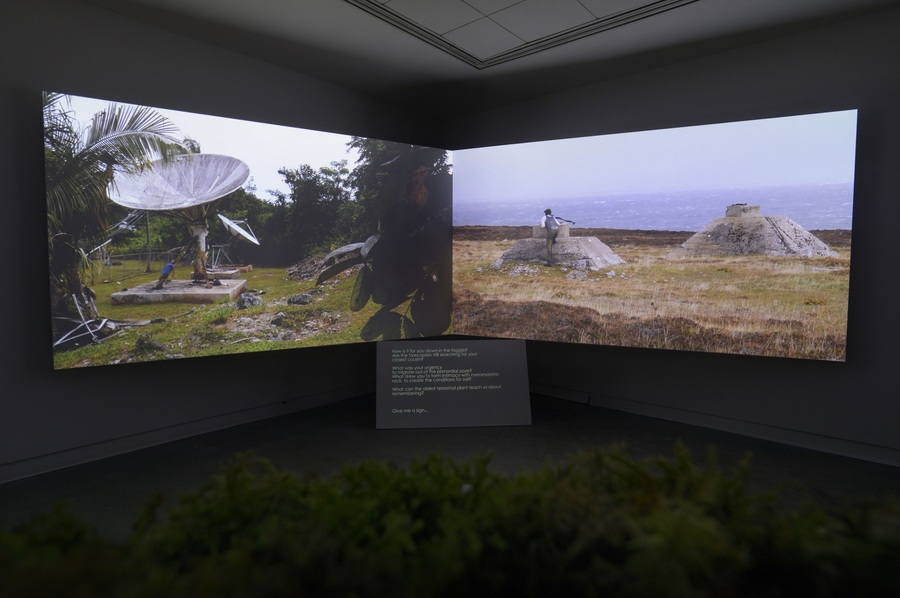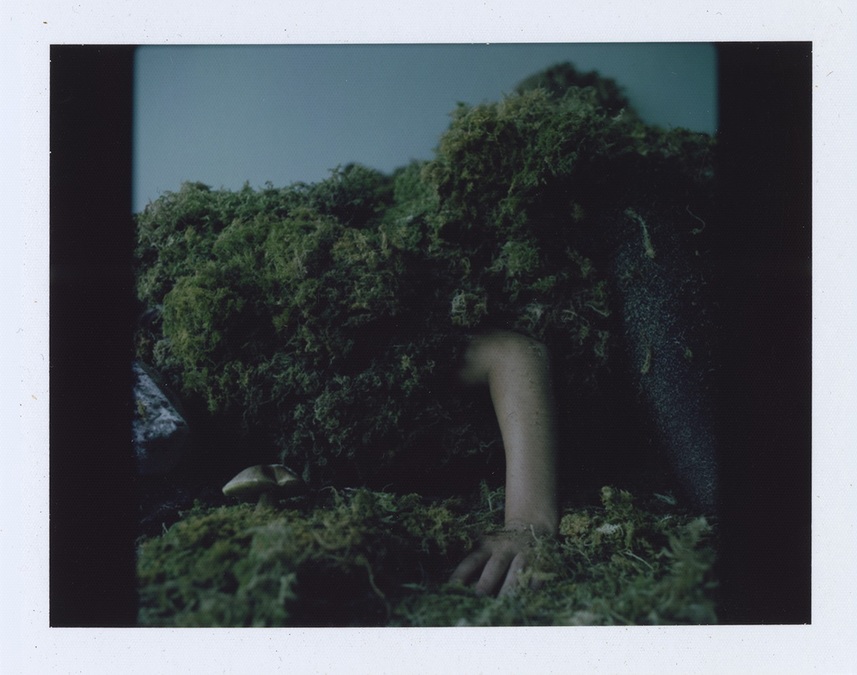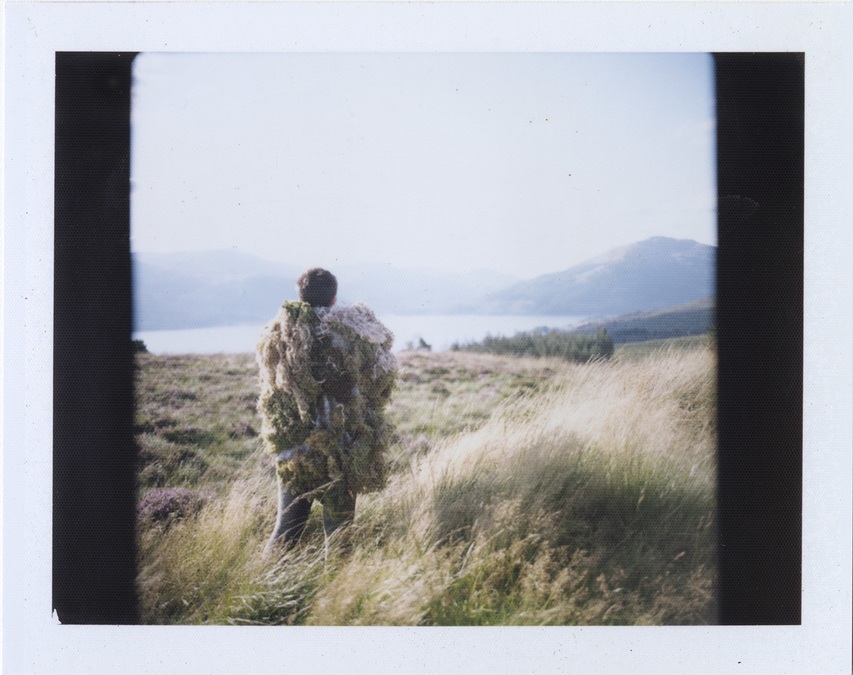Margaret Tait Winner Emilia Beatriz on barrunto
Bringing together environmental grief, experimental science and artistic collaboration, Margaret Tait Award-winning artist Emilia Beatriz discusses their plans for 2020
Sitting at their kitchen table ahead of the announcement of this year's Margaret Tait Award, Emilia Beatriz speaks openly and insightfully about the work they’ll make in the year ahead. Listening to the artist, it’s clear the work will involve a dual process of intuition and organisation.
Emilia's proposal – entitled 'barrunto' – involves griefwork practices, experimental physics, collaborations with performers and other artists, a search for Scotland’s disappearing bumblebees, and a commitment to accessible forms of artwork. In fact, the project pivots on one of the central strategies for making diverse works more widely accessible to audiences: translation.
Much of what Emilia has planned involves “filmically, sonically and performatively” opening out the Spanish-language term barrunto (commonly used in Puerto Rico) to Scottish and international audiences. As expressed in their proposal, barrunto is a “foresight (or more accurately forefeel)... noticed through signals presented via the environment.” Emilia also quotes a horoscope by astrologer Chani Nicholas, describing barrunto as “direct access to visions of the future that are trying to break through to us in the present.”
Environmental grief and Puerto Rico
Barrunto can involve being sensitive to environmental indicators of what might happen in the future, such as feeling atmospheric shifts in your bones, and this idea intersects with some of Emilia's thoughts around grief and griefwork. “My work is situated [in] relationships between bodies and land. For me, griefwork can be about attuning to the ecological and environmental feelings of loss or crisis, and also situating that within a personal narrative. When I’m talking about griefwork, it’s about being present in the body.”
A journey through the stages of grief is often thought to end with acceptance. Emilia suggests a careful distinction to be made between an active acceptance of trauma, and the unquestioning “assimilation” of grief into your life. "I am interested in griefwork that is accountable to both the past and the future, griefwork as history-making that can help heal the wounds of historical erasures. Griefwork as paying attention to the losses a body can't incorporate. In moving through environmental grief, can there be acceptance without assimilation (for example, of the violences contributing to climate crises)?"
This line of enquiry isn’t an abstract research interest. It's intimately attached to Emilia's experiences following one of the worst natural disasters in recent history, when Hurricane Maria struck Puerto Rico in 2017. Exchanges with loved ones, family, friends and collaborators on the island have challenged many of the artist's own presumptions about loss, land, transformation, life and death.
One particular conversation comes to mind: “After the hurricanes I texted my friend Mapenzi Nonó, who lives on a smallholding. I asked her which of her trees survived the storm. Instead of replying which ‘lived’ and which ‘died’, she sent me a list of all the different trees and their states in relation to the land. ‘The tamarind is bearing fruit again. The mango is fighting to pull itself together. The guava is full of new leaves from the stress of the wind. The lemon, achiote, breadfruit and moringa have transformed into compost.’
"She flipped this narrative for me. That made me pause and has helped me think about centring different languages and practices when dealing with the situation we’re facing.”
Science, history, and the diasporic experience
As a way of incorporating these more porous ideas of life and death into barrunto, Emilia plans to incorporate characters that featured in a film work which appeared at Glasgow's CCA last summer – a forecast, a haunting, a crossing, a visitation. “[The characters in this work] arrived through archival and oral research", Emilia explains, "and as I was writing they appeared to me.”
One is Vampire Cats, a metaphor to describe the varroa mites which feed on the blood and fat of honey bees. Another is Monstrous Crabs. “[This] came from descriptions by Scottish colonisers of Vieques Island in the archipelago of Puerto Rico while trying to settle. The Scots noted that the island was uninhabited except for ‘monstrous crabs’. What they did not see was the genocide of indigenous populations that had already taken place, so for me these crabs become this ‘monstrous’ signal of loss.”
There is also Zombie Moss, which came to Emilia through visits to plant museums, and studying a specific moment in prehistory. “Some hundreds of millions of years ago, moss emerges as the first terrestrial or non-aquatic plant. So moss helps creates the conditions for soil and therefore all other plants and animal life… That really sparked my curiosity.
"I learned that, unlike other specimens in a natural history museum that have to be killed in order to be preserved, many mosses have the characteristic that they can basically be reactivated given the right conditions, such as light, water and a substrate they can attach to. They can be completely dried out, held in an archive storage cupboard for a hundred years, and then potentially come back to life.
"That’s how [the character] Zombie Moss emerged. As a material of living memory, whose existence challenges the life or death binary, moss teaches me about remembering and forgetting, living and grieving, history making and matter-in-touch-with-matter-no-longer-touching, which is a personal definition for quantum entanglement.”
It’s in talking about Zombie Moss that Emilia begins to touch on their curiosity about experimental physics, and an understanding of this in light of the diasporic experience, but is clear that they are in the initial stages of learning about this.
"I’m not a scientist… My readings of physics are messy and poetic. But from what I understand, classical physics – including Einstein’s thoughts – are based on the idea that two different particles are governed by ‘locality’. So, if I’m over here and you’re over there, first of all, we can’t affect each other at a distance, and secondly, we’re separate, individual things…
"Quantum physics is disproving one or both of those theories, and scientists at Glasgow University managed to take a picture of this! [The result are] these beautiful sparkly images showing simultaneous ‘entangled’ action at a distance... They’re using this to prove what we already know from our bodies and from the land, especially in diasporic contexts – that matter affects matter even when it’s no longer touching.”
For Emilia this branch of science can offer a way of understanding diasporic experience. “It feels like having two different times and places in my body at once, two homes, two islands. These different realities.” This is often taught to be experienced as a dislocation. “But when I look at these images [of quantum entanglement], or when I think about moss that exists only in the most Southern point of Chile and in Northern Norway, only in these two distinct parts of the world because it travels on bird’s feet, I can’t think of [diasporic experience] as dislocation any more.
"I think about it as a non-local connection, an awareness and experience that is crossing borders. And that is what it is for me to be entangled; what’s over there is part of me, here.”
Materials and Technology
As well as the various ideas going into the mix for the year of filmmaking ahead, Emilia also speaks about the materials they intend to use. One particular interest is to disturb some of the expectations of obsolescence. In returning to previous intentions to disrupt binaries of life and death, Emilia will look at what happens when filmstock or chemicals have 'expired'. “It’s obsolete, it’s dead as a process," they say. "But it still actually has a different kind of life and lets different kinds of light in. Sometimes you get these bands of light, and that’s time marking itself on the film.”
When speaking about present technologies, and relationships with cloud storage and computing, Emilia problematises this comfortable sense of permanence with reminders of how smartphones and other gadgets fare in times of the most extreme hardship. “There’s the idea that the digital will last," they say, "and that you can preserve something forever. In Puerto Rico we live without stable electricity. I know what it’s like not to have access to the digital. It does degrade and it’s important to be in touch with those degradations.”
This line of thinking is inspired by work happening in the Caribbean post-hurricane; for example, through workshops on how to develop film in beer at Beta Local, an artist-run space in San Juan, Puerto Rico's capital. “We still want to make images in a crisis state, or when the garbage isn’t being picked up. Sofia [Gallisá Muriente] showed work as part of declarations on soil and honey [Emilia's CCA exhibition] of archival film that she’s degraded in salt. These things inspire me and nourish my work.”
Collaboration
The role of Emilia’s friends in motivating the artist's own practice extends beyond mutual influence. A key element of their proposal is extended collaborations with other artists. For example, as in declarations on soil and honey, artist Kiera Coward Deyell will be extensively involved with the sound design. Glasgow-based artists Alicia Matthews and Nima Séne will also contribute to the Zombie Moss character.
During the interview, Emilia brings up an archaic meaning of the word “conversation”, as a means of illustrating some of the inherent potential of working collaboratively. “Conversation used to mean the place where one lives or dwells, the manner of conducting oneself in the world, to keep company with, to turn or bend together.
"How we’re living together, conversation, is a core of collaboration and an acknowledgement... [of] the different ways in which we all affect each other.”
The work that Emilia is completing with Deyell involves working with sounds as a sensual and felt aspect of watching film. “I’m excited to work with Kiera on vibration and sounds that are on the limit of what can be heard. Kiera’s work opens up experiences that will heighten what it means to be in a cinema, which is [already] such a sensual experience.”
Emilia thinks of the cinema as being “one of the most accessible spaces for art. Going to the cinema is such a common experience." Emilia continues: "It’s important to me to incorporate modes of interpretation and accessibility into the production, because it might change how I make the work – which is great! – and doing that in conversation and consultation with folks with different experiences to mine.
"It’s about gaining an intimacy in translation or accessibility, whether that’s a sensual [matter] of sound being felt as much as it is heard, or something else.”
In this vein, Emilia hopes to expand the experiences of audiences and make this fundamental to the conception and production of making work, rather than an add-on. “That’s at the core of how I want to make work, and something that many disabled and Deaf artists are doing already. But I don’t think it’s done enough in the mainstream.
"Accessibility is important on many levels. Making work that can be read by people like me and also people not like me. Accessibility can also be about making a screening free, or distributing the work online, so people can watch it from bed, or across the world.”
Ending the interview, Emilia shares a local tip on being sensitive to the kinds of natural phenomena encompassed in the term 'barrunto'. “Hawthorn berries," Emilia says, "they’re everywhere. They’re edible and medicinal, and in Scottish folklore, they’re seen to be pathways between the living and the dead. The berries are rich sources of vitamin C, and they also work on your heart and can support the symptoms of grief.
"I was paying attention to them this year and the hawthorn berries were everywhere. And someone said, that means it’s going to be a long winter, because the trees produce extra berries to support the birds during the winter. So this huge flowering of the red berry gives you a sense of what’s to come, which is also a sense of what’s happened.”
Like those bright red berries before a powerful winter, a conversation with Emilia Beatriz is full of erudition, insight and excitement that promise a beautiful and original film to come.
Emilia Beatriz's new film barrunto will be completed over the course of the next 12 months, and will screen in Glasgow in early 2021
The 2020/21 Margaret Tait Award was presented at Glasgow Film Festival


